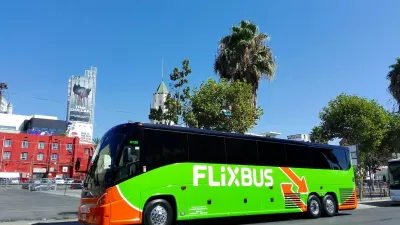As the company shutters stations, passengers are left without shelter, basic amenities, and often farther from central cities and transit connections.

Inter-city bus riders in more and more U.S. cities find themselves having to wait in outdoor parking lots or sidewalks as Greyhound continues to close many of its indoor waiting areas, reports Kea Wilson in Streetsblog USA.
The carrier has been shutting down stations since it sold its stations in 2022 following the company’s sale to Flixbus in 2021. “Some of those stops are located in suburbs miles from the core downtowns where terminals used to be located, with few transit connections for passengers who can't afford a ride to their ride.”
The move is partly a result of newer budget bus companies that purport to keep prices low by eliminating stations. “By ditching the traditional depot — and slashing thousands of station-based jobs in the process — these bus line “disruptors” were able to increase service and cut prices to the bone, even as they added amenities like onboard charging points and WiFi,” Wilson explains.
While some decommissioned stations are being converted to affordable housing and other uses, Greyhound’s core demographic will suffer from the changes. “In an era of accelerating climate change and traffic violence, shared modes like buses and trains should be our mode of first resort, especially on busy holiday travel weekends like this one, which are expected to spike 2.3 percent.”
FULL STORY: As Greyhound Stations Go Extinct, Low-Income Thanksgiving Travelers are Left Out in the Cold

Alabama: Trump Terminates Settlements for Black Communities Harmed By Raw Sewage
Trump deemed the landmark civil rights agreement “illegal DEI and environmental justice policy.”

Study: Maui’s Plan to Convert Vacation Rentals to Long-Term Housing Could Cause Nearly $1 Billion Economic Loss
The plan would reduce visitor accommodation by 25% resulting in 1,900 jobs lost.

Why Should We Subsidize Public Transportation?
Many public transit agencies face financial stress due to rising costs, declining fare revenue, and declining subsidies. Transit advocates must provide a strong business case for increasing public transit funding.

Paris Bike Boom Leads to Steep Drop in Air Pollution
The French city’s air quality has improved dramatically in the past 20 years, coinciding with a growth in cycling.

Why Housing Costs More to Build in California Than in Texas
Hard costs like labor and materials combined with ‘soft’ costs such as permitting make building in the San Francisco Bay Area almost three times as costly as in Texas cities.

San Diego County Sees a Rise in Urban Coyotes
San Diego County experiences a rise in urban coyotes, as sightings become prevalent throughout its urban neighbourhoods and surrounding areas.
Urban Design for Planners 1: Software Tools
This six-course series explores essential urban design concepts using open source software and equips planners with the tools they need to participate fully in the urban design process.
Planning for Universal Design
Learn the tools for implementing Universal Design in planning regulations.
Smith Gee Studio
Alamo Area Metropolitan Planning Organization
City of Santa Clarita
Institute for Housing and Urban Development Studies (IHS)
City of Grandview
Harvard GSD Executive Education
Toledo-Lucas County Plan Commissions
Salt Lake City
NYU Wagner Graduate School of Public Service





























